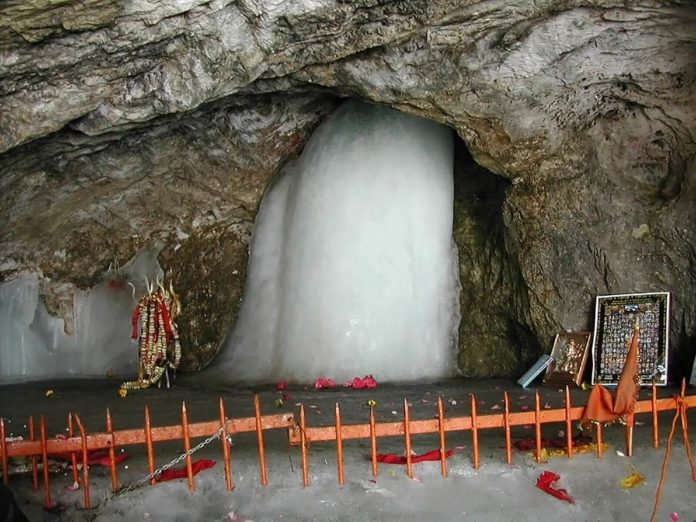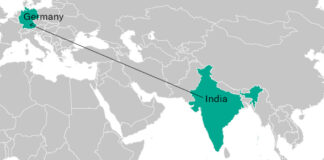Ancient scriptures and traditions of India tell that Amarnath Dhaam is the abode of Bhagwan Shiva Shankar, the eternal and original deity of whole creation. The Ice-Lingam, created naturally within the Holy cave, represents Bhagwan Shankar Himself.
By Team jammukashmirnow.com
Listen 0 Devi, I tell of the Mahaattintha Amreeshvara By listening to which alone, one is freed of millions of grave sins.” …Amarnath Mahatmya
Amarnath Mahatamya describes the divine sanctity and legends of the Amarnath and the religious merit associated with the Yatra to the shrine which it calls Amreesh Maheeshvara’. Ancient scriptures and traditions of India tell that Amarnath Dhaam is the abode of Bhagwan Shiva Shankar, the eternal and original deity of whole creation. The Ice-Lingam, created naturally within the Holy cave, represents Bhagwan Shankar Himself. Hence Amarnath Dhaam has been a venerated Shrine of whole humanity since the earliest times The spiritual legacy of Shrine dates to the time when humanity had not been partitioned into Hindus, Muslims Christians etc. Accordingly. the shrine of Amaranth relates to the composite universe, undivided beyond the sectarian divisions of caste, creed and region.
The Holy Amarnath Cave is situated at a distance of 140 kms from Srinagar. Major Bates writing 150 years ago tells: “The celebrated cave, [Lat. 34 -13′:Elev. of survey Station 16,442 feet; of snowy peak 17,321, feet which is annually visited not only by the Hindus of Kashmir, but the pilgrims of that faith from whole Hindustan, of every rank and caste, is an enormous fissure on the south side of the mountain, situated in a deep and narrow valley, which is bounded by steep and lofty mountains and traversed by a torrent which flows from a very! large glacier at its upper end. The opening of the cave is about 200 or 300 feet above the torrent, and the path leading up to it! is steep and rocky; it passes straight inwards for about 75 feet. and then turns to the right for about 125 feet…The great festival takes place in the Hindu month Sawan, the day depending upon the moon’s age (in 1870 it occurred on the 11th August). Vi explains that Amr signifies the immortal, and nath is a Sans word applied to the principal Hindu divinities, as lords masters, chiefly to Vishnu or Krishna, and occasionally to Siva and also to the place where they worshipped and supposed more particularly to reside” The Holy Cave is 50 feet long and 25fe broad at a height of approximately 15.000 feet from the sea level.
The Shrine and the Yatra is described in Nilmat Puran earliest scripture of Kashmir available today.
While the date of the composition of the Puraan is in the hoary antiquity, the lowest limit of its recession is fixed at in 4-5th centuries of Christian around the time King Constantine was getting converted to Christianity. Islam was yet three whole centuries away. Mid-12 century work Raj Tarangini of Kalhana’, which is regarded as the earliest regular history in whole of the subcontinent, mentions the Holy Cave and the pilgrimage to it. Thus Amarnath Dhaam has been a well-known tirtha all through the period of known history. In the medieval times, the Shrine and the pilgrimage may have been suppressed for obvious reasons. The Shrine was ‘rediscovered’. as per the local traditions, by a shepherd some three centuries ago. He had darshana of the natural Ice Lingam when he entered the cave in search of a lost eve. Another tradition says that Shiva himself in the garb of a Sadhu, told a Gujar, Buta Malik, about the cave. He gave Buta Malik a sacful of coals. When on reaching home, he opened the sac it was full of gold mohars. Wonderstruck he set out in search of the sadhu and came upon the Amarnath cave. There he had darshana of Bhagwan Shiva in the shape of Ice-lingam. An indication of the hoary antiquity of this Shrine is that Adishankara from remote Kerala has worshipped here. Shankaracharya hill in Srinagar commemorates his visit. Swami Ramtiirth, Swami Dayanand, Swami Vivekananda too have paid visits. Sister Nivedita, who accompanied Swami Vivekananda, has described its environs, the quite valley and the holy status of the shrine, in her memoirs.
The founding of this Amarnath Shrine stems from Bhagwan Shiva relating the legend of Amarnath Dhaam to Mata Parvati. It is described in the interesting tale of Narada eajoling Mata Parvati to ask Bhagwan Shankar about the rundd-maalaa (the garland of skulls) worn by him. There upon, Bhole Naath told her that it carried her skulls from different births. At this Mata Parvati realised that she was still in the bondage of birth and death. She, therefore, began to persuade Shiva to relate to her the legend of Amaranth hearing which turned mortal beings immortal.
However, prior to beginning the legends, Shankara brought Kaalagni and ordered him to burn up all the bushes and hedges around so that none besides the two could listen to it. Accordingly, Kaalagni cleared the place of every object. However, a parrot’s egg lying beneath the skin-seat of Shankara was not removed. Bhagwan Shankara started the legend. After sometime, Mata Parvati who had been uttering ‘haan-haan’ in response to the tale began to feel sleepy. The egg burst open and the parrot emerging from it, continued to utter haan-haan’ (aye-aye) in place of Mata. Thus, he too became immortal. As Shuk-deva he attained the gvaana of all the four Vedas and eighteen Puraanas. Another tradition is that a pair of pigeons too heard the mystery of creation and destruction being revealed by Bhagwan Shankara. Both of them transcended death. It is said that every year, the pair of pigeons comes for darshana of the Ice Lingam. Many pilgrims have seen them.
Amarnathji Yatra starts from Pahalgam which is 96 km away from Srinagar. The mountain ranges and thick forests of the locale take one’s breath away. From Pahalgam, the Holy cave is at a distance of 46 km. The first the 16 km to Chandanwari is motorable. After night-halt at Chandanwari, the pilgrims begin the Yatra at day break, It is said that Bhagwan Shiva had freed his Chandan (skull) of its locks at this spot. Hence, the name. Pilgrims hire tents, sticks etc. at Chandanwari. Horses and ponies too are available here. This station is at a height of 7,800 feet.
The next stop is Pissu Top. The legend says t pleas of Deevas, Bhagvaan Shankara had ground the del pestered the devas, to dust at this place. The event is reme the name of Pissu (grinding) Top. River Lambodari Kashmiri) flows along the Yatra route.
The next stop is Sheesh Nag at an altitude of 11.000. There is a huge frozen lake there. It is said that Bhagvaan She had discarded the Nagas worn around his neek, at this spot the garlands at this pond. Some distance ahead, he also left bal his darling son Ganesha This is the Ganesha Parvat, which is called Mahagunas in Kashmiri. Now, the Yatra arrives at Pancho It is said that Bhole Shankar and Mata Parvati performed a taanddau at this place, and five rivulets of the ganga issued from his jattas. Here the pilgrims take a bath and refreshed, arrive at the Holy cave after a 4-5 hour trek, for the cherished darshana of Baabaa Barfaani.
A week prior to Rakshbandan (Shravan Puurnimaa), the Holy Mace (Charri Mubarak) is taken from Dashnaamii Akhaadda of Srinagar led by Mahant Swami Dipendra Giri. The Yatra, for the next station begins after prayer and puja at Shankarachrya Temple. Thousands of sadhus and devotees start for the Holy cave on foot accompanying the Holy Mace, and chanting ‘Shiv Shankar Ki Jai’. The Holy Mace, halts, for the night at each of the major stations on the Yatra-route and, after prayer and puja there, starts for the next one arriving at the Holy cave on Raksha Bandan. The Holy Mace is laid beside the sacred Ice Lingam with full rituals amid chanting of Vedic mantras and Shiva stou and worship of Shiva-Shakti. Then Mahant Dipendra Giri along win sadhus worship Ice Lingam and the Holy Mace. The Yatra is cay completion with this prayer and puja.








